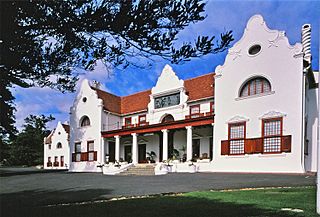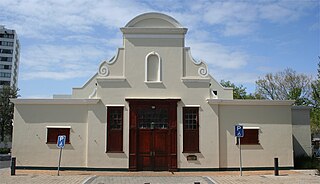
Groote Schuur Hospital is a large, government-funded, teaching hospital situated on the slopes of Devil's Peak in the city of Cape Town, South Africa. It was founded in 1938 and is famous for being the institution where the first human-to-human heart transplant took place, conducted by University of Cape Town-educated surgeon Christiaan Barnard on the patient Louis Washkansky.

Rondebosch is one of the Southern Suburbs of Cape Town, South Africa. It is primarily a residential suburb, with shopping and business districts as well as the main campus of the University of Cape Town. The area is noted for its beautiful views of Table Mountain, its convent location to the rest of the city of Cape Town, and its proximity to the University of Cape Town.

Groote Schuur is an estate in Cape Town, South Africa. In 1657, the estate was owned by the Dutch East India Company which used it partly as a granary. Later, the farm and farmhouse was sold into private hands. Groote Schuur was later acquired by William De Smidt, and remained in the family's possession until it was sold by Abraham De Smidt, Surveyor General of the Cape Colony, in 1878, and was bought by Hester Anna van der Byl of the prominent Van Der Byl / Coetsee family. In 1891 Cecil Rhodes leased it from her. He later bought it from her in 1893 for £60 000, and had it converted and refurbished by the architect Sir Herbert Baker. The Cape Dutch building, located in Rondebosch, on the slopes of Devil's Peak, the outlying shoulder of Table Mountain, was originally part of the Dutch East India Company's granary constructed in the seventeenth century.

The Liesbeek River is a river in Cape Town in South Africa. It is named after a small river in the Netherlands. The first "free burghers" of the Dutch East India Company were granted land to farm along the river in 1657, shortly after the first Dutch settlers arrived in the Cape. The river was originally called the Amstel or Versse Rivier. It is the first river that Jan van Riebeeck named.

Newlands (Nuweland) is an upmarket suburb of Cape Town, South Africa. It is located at the foot of Table Mountain in the Southern Suburbs of Cape Town, and is the wettest suburb in South Africa due to its high winter rainfall. The neighborhood of Bishopscourt is situated to its south west, Claremont to its south east, and Rondebosch to its east and north east.

The Southern Suburbs are a group of Anglophone suburbs in Cape Town, Western Cape, South Africa. This group includes, among others, Observatory, Mowbray, Pinelands, Rosebank, Rondebosch, Rondebosch East, Newlands, Claremont, Lansdowne, Kenilworth, Bishopscourt, Constantia, Wynberg, Ottery, Plumstead, Diep River, Bergvliet and Tokai. The area is also commonly referred to as the Cape Peninsula, often including the towns further South such as Fish Hoek.

Mowbray is one of the Southern Suburbs of Cape Town, South Africa and lies on the slopes of Devil's Peak. Mowbray is at a junction of several major Cape Town highways and has an important multi-modal public transport interchange at Mowbray railway station. Its original name was Driekoppen.

The Valkenberg Hospital is a large, government-funded, tertiary psychiatric hospital in the city of Cape Town, South Africa.

Rosebank is one of the Southern Suburbs of Cape Town, South Africa, located between the suburbs of Mowbray and Rondebosch.
Hospital Bend is a major freeway junction, located to the east of the central business district of Cape Town, South Africa. It is the junction between the N2 national route and the M3 metropolitan expressway. Its unusual design led to notoriety as a traffic bottleneck and a frequent accident location; between March 2008 and early 2010 it underwent major roadworks to address these issues. It takes its name from it curving around the grounds of Groote Schuur Hospital.

Observatory railway station is a Metrorail station serving the suburb of Observatory in Cape Town. It is served by trains on the Southern Line.
Raapenberg Bird Sanctuary is a 10-hectare (25-acre) protected area in Cape Town, located on the Liesbeek river near the suburb of Observatory.
The following is a timeline of the history of Cape Town in the Western Cape province of South Africa.

The Heart of Cape Town Museum is a museum complex in the Observatory suburb of Cape Town, South Africa. It is in the Groote Schuur Hospital on Main Road. The hospital was founded in 1938 and is famous for being the institution where the first human heart transplant took place, conducted by University of Cape Town-educated surgeon Christiaan Barnard on the patient Louis Washkansky. The museum opened on December 3, 2007, marking the 40th anniversary of the heart transplant by Christiaan Barnard. The Heart of Cape Town Museum honors everyone who played a major role in a surgical feat that created a new medical era. It also brings attention to ethical and moral implications that came up at the time. It also highlights the ways in which Barnard's accomplishment put South Africa and the University of Cape Town on an international stage.
Frances Rix Ames was a South African neurologist, psychiatrist, and human rights activist, best known for leading the medical ethics inquiry into the death of anti-apartheid activist Steve Biko, who died from medical neglect after being tortured in police custody. When the South African Medical and Dental Council (SAMDC) declined to discipline the chief district surgeon and his assistant who treated Biko, Ames and a group of five academics and physicians raised funds and fought an eight-year legal battle against the medical establishment. Ames risked her personal safety and academic career in her pursuit of justice, taking the dispute to the South African Supreme Court, where she eventually won the case in 1985.

The Groote Schuur Zoo was a 2-hectare (4.9-acre) zoo in Cape Town, South Africa. Established in 1931 at the request of deceased Cecil Rhodes, it was free of charge and a very popular attraction in Cape Town until its closure sometime between 1975 and 1985. The zoo shut down due to a combination of the financial burden that the Apartheid government faced and an increase in animal welfare standards. During its operation, it housed many animals including lions, emu's, crocodiles and tahrs. The zoo can still be visited today, as it has been abandoned and left open to the public. The most prominent feature of the zoo is the Lion's Den, both when it was open and today where it still stands, full of overgrown vegetation.
Elmi Muller is a South African medical specialist who specialised in General Surgery and Transplantation. She currently performs kidney as well as liver transplants in both adults and children. She is the past President of the Southern African Transplantation Society who pioneered an organ transplant programme at Groote Schuur Hospital in Cape Town for HIV positive patients using HIV positive donors. She also serves on the Executive committee of The Transplantation Society of which she currently is the vice-president. Elmi was the Chair/Head of the Division of General Surgery at Groote Schuur Hospital, University of Cape Town. She currently serves as Dean: Faculty of Medicine and Health Sciences at Stellenbosch University.

Coornhoop is a historic 17th century farmhouse. It is located at 2 Dixton Road in Observatory, Cape Town. Currently, it houses the Centre for Conflict Resolution.

The following outline is provided as an overview of and topical guide to Cape Town:

The M4 is a long metropolitan route in the City of Cape Town Metropolitan Municipality in South Africa. It connects the Cape Town CBD with the Cape of Good Hope via Wynberg, Muizenberg and Fish Hoek. Originally, it was the main route connecting the Cape Town CBD with the Southern Suburbs and is thus named Main Road for much of its length. From the CBD to Kirstenhof, it is parallel to the M3 Freeway.



















